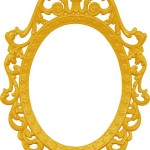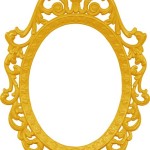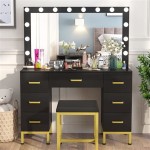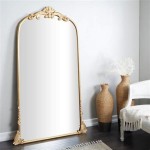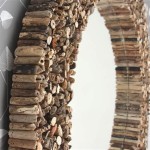How Big Should A Mirror Be For A 36-Inch Vanity Unit?
Selecting the appropriate mirror size for a 36-inch vanity unit involves careful consideration of both aesthetics and functionality. The mirror serves not only as a practical tool for daily grooming but also as a key design element that influences the overall look and feel of the bathroom. Finding the right balance between these two aspects is crucial for creating a harmonious and visually appealing space.
A mirror that is disproportionately small can appear lost above the vanity, while an oversized mirror might overwhelm the space and detract from other design features. Therefore, understanding the factors that contribute to optimal mirror sizing is essential for achieving a well-balanced and functional bathroom design.
This article will delve into the key considerations for determining the ideal mirror size for a 36-inch vanity unit, including width, height, and shape, providing guidance to navigate the options effectively.
Width Considerations
The width of the mirror is arguably the most critical dimension to consider. A general guideline suggests that the mirror should be approximately the same width as the vanity unit, or slightly narrower. For a 36-inch vanity, a mirror that is between 30 and 36 inches wide is typically recommended. A mirror that is exactly 36 inches wide will create a seamless and balanced look, visually anchoring the vanity to the wall.
Choosing a mirror slightly narrower than the vanity, such as 30 to 34 inches, can also be a suitable option, especially if the vanity is flanked by other elements such as sconces or wall cabinets. This approach allows for some visual breathing room and prevents the mirror from dominating the entire space. However, it is important to ensure that the mirror is still wide enough to provide adequate visibility for grooming tasks.
Avoid selecting a mirror that is significantly wider than the vanity. This can create a sense of imbalance and make the vanity appear smaller than it actually is. An oversized mirror might also encroach upon adjacent wall space, potentially interfering with the placement of other fixtures or accessories. Careful measurement and consideration of the surrounding elements are vital in determining the optimal mirror width.
Consider the style of the vanity. If the vanity has prominent side details or decorative features, leaving a few inches of space on either side of the mirror can highlight these elements. Conversely, if the vanity has a minimalist design, a mirror that spans the full width can create a more substantial and impactful statement.
Height Considerations
Determining the appropriate height of the mirror involves considering both the ceiling height and the height of the individuals who will be using the vanity. There is no single magic number, but several factors contribute to finding the ideal height.
A common rule of thumb is to position the center of the mirror at approximately eye level. This ensures that the primary users of the vanity can comfortably see their reflection without having to strain or bend. The average eye level is around 63 inches from the floor, but it is important to adjust this based on the specific heights of the individuals in the household.
The height of the ceiling also plays a role in determining the appropriate mirror height. In bathrooms with standard 8-foot ceilings, a mirror that is 30 to 36 inches tall is often a good choice. This allows for sufficient reflection without feeling cramped or overwhelming.
In bathrooms with higher ceilings, such as those with vaulted ceilings, a taller mirror can be used to visually fill the vertical space and create a more dramatic effect. A mirror that is 40 inches or taller might be appropriate in this scenario. However, it is important to maintain a sense of proportion and avoid selecting a mirror that is so tall that it becomes difficult to reach or clean.
The distance between the top of the vanity and the bottom of the mirror is another important consideration. A general suggestion is to leave at least 4 to 8 inches of space between the vanity countertop and the bottom edge of the mirror. This prevents the mirror from being too close to the countertop and allows for adequate clearance for faucets and other fixtures. Too little space makes the mirror seem crowded and can make cleaning harder.
Consider the overall design aesthetic. A taller mirror can create a more formal and elegant look, while a shorter mirror can create a more casual and relaxed feel. The final height should complement the overall design style of the bathroom.
Shape Considerations
The shape of the mirror plays a significant role in the overall aesthetics of the bathroom. Common mirror shapes include rectangular, square, round, and oval, each offering a unique visual appeal.
Rectangular mirrors are a classic and versatile choice that works well with a variety of vanity styles. A rectangular mirror that spans the width of the vanity can create a sense of symmetry and balance. They are also efficient, providing more reflective surface area than other shapes while still not overly dominating the space.
Square mirrors can add a touch of modernity and sophistication to the bathroom. A square mirror that is centered above the vanity can create a focal point and add visual interest. Consider a square mirror for a contemporary design scheme.
Round mirrors offer a softer and more organic aesthetic. A round mirror can help to break up the hard lines of the vanity and other rectangular elements in the bathroom, creating a more harmonious and inviting space. Round mirrors are particularly well-suited for bathrooms with a more relaxed or bohemian style. The curvature adds softness. They can also create a unique focal point.
Oval mirrors offer a similar aesthetic to round mirrors but with a slightly more elongated shape. An oval mirror can be a good choice for bathrooms with limited wall space, as it can provide a larger reflective surface area without taking up too much width. Their slightly elongated shape can also make the ceiling seem higher than it is.
Consider the other shapes in the bathroom. If the vanity has rounded edges, a round or oval mirror can complement these curves. If the vanity is more angular, a rectangular or square mirror might be a better fit. The goal is to create a cohesive and balanced design that is visually appealing.
Framed or frameless mirrors are also key shape considerations. Framed mirrors often add a touch of elegance and can match the metal finishes of the faucet and other hardware, providing a put-together, matching look. Frameless mirrors offer a modern minimalist look. These mirrors often make bathrooms look bigger, because they reflect more light, and aren't visually heavy like a framed mirror.
Ultimately, selecting the ideal mirror size and shape for a 36-inch vanity unit requires careful consideration of the room's dimensions, the individual needs of the users, and the overall design aesthetic. By taking these factors into account, one can choose a mirror that enhances both the functionality and the visual appeal of the bathroom, creating a space that is both practical and beautiful.

Bathroom Mirror Size Calculator

Top Mistakes To Avoid When Choosing A Mirror Size For Your Bathroom Vanity Ace Decor

Standard Bathroom Mirror Sizes With 2 Drawings

Bathroom Mirror Size Calculator

Size It Right Your Essential Bathroom Mirror Guide

Paihome 24 In W X 36 H Large Rectangular Metal Framed Wall Mounted Bathroom Mirrors Vanity Mirror Black Hd 24361 Drbl The Home Depot

Famyyt 36 In W X 24 H Rectangular Aluminum Framed Beveled Edge Horizontal Vertical Wall Bathroom Vanity Mirror Silver Xj Al3624s L The Home Depot
Bathroom Design Quick Tip Where To Place The Mirror When Your Sink Is Off Center Designed

Luxury Dimmable Led Bathroom Mirror 72 X 36

36 In W X 54 H Modern Simple Rectangular Black Wood Frame Bathroom Vanity Mirror Wall Floor Mzzj 91137 Bk A The Home Depot
